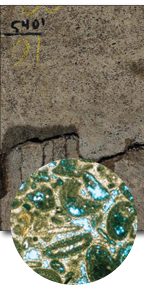Potential Oil-Prone Areas in the Cane Creek Shale Play, Paradox Basin, Utah, Identified by Epifluorescence Microscope Techniques
By: Thomas C. Chidsey, Jr., David E. Eby

GET IT HERE
The Cane Creek shale of the Pennsylvanian Paradox Formation has produced more than 7.8 million barrels of oil and about 7.9 billion cubic feet of gas from 18 fields in the Paradox Basin of southeastern Utah. The Cane Creek is divided into three intervals—A, B, and C; the B interval is the primary oil producer. Finely crystalline dolomites and sandstones in the B interval have been the main targets of successful horizontal drilling programs. Hydrocarbon shows were recognized using nondestructive epifluorescence (EF) microscope techniques on samples from wells in the northern part of the basin. A new, qualitative visual EF rating system was developed and applied to these samples. A variety of EF ratings from each well were plotted and mapped.
This 44-page Special Study provides (1) a summary of the new EF methods used in the study; (2) detailed petrographic and EF descriptions of Cane Creek samples for 31 wells (in three appendices); (3) 16 maps showing potential oil-prone areas for the entire Cane Creek and the A, B, and C intervals; and (4) a statistical analysis of the EF data. The study will help petroleum companies determine exploration strategies and land acquisition areas. It will also be a reference for government land management agencies, county planners, and local landowners in decision making processes and resource assessments.












